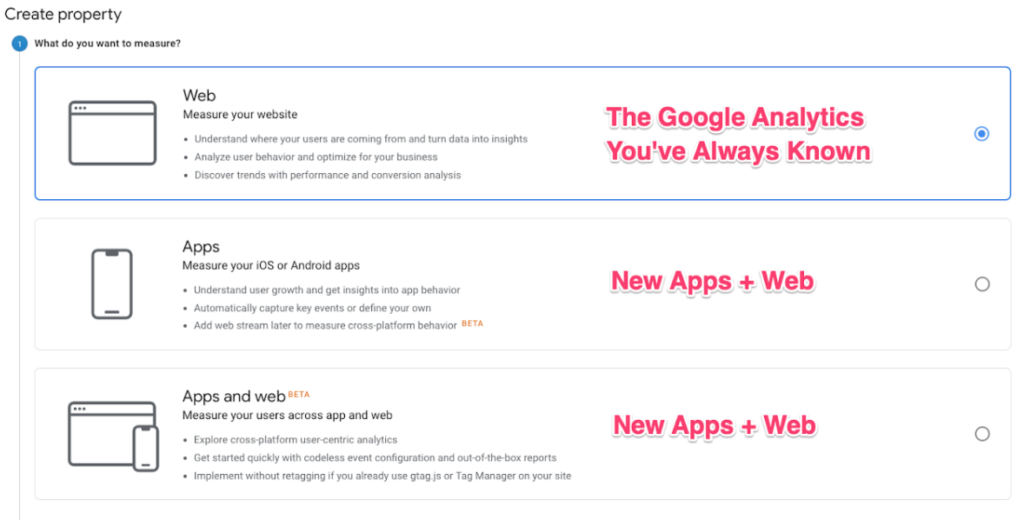Our head of innovation, Charles Farina, just launched Analytics Bootcamp, a new 3-Part webinar series. The first installment covered the latest version of Google Analytics App+Web features and Tag Manager. If you missed it, we’ll be hosting additional Bootcamp dates in starting on July 14th, so stay tuned to our blog for registration details. In the meantime, below are the key App + Web and Google Tag Manager takeaways. Also, be sure to check out the recaps of Bootcamp Part 2: Optimize and Part 3: Data Studio. 1. What is App + Web? You now have the ability to explore user-centric data across your app and website in one view by creating a new property in Google Analytics.  2. What’s new and exciting about App + Web? New cross-platform reports, real-time reports and user streams, automatic measurement, new audience builder and so much more! Read Charles’s blog for a complete overview of the new features in App + Web . 3. You should consider implementing Google Tag Manager. If you’re looking to speed up your load times, consolidate your tags, or simplify your tag management workflows, you should consider implementing Google Tag Manager.
2. What’s new and exciting about App + Web? New cross-platform reports, real-time reports and user streams, automatic measurement, new audience builder and so much more! Read Charles’s blog for a complete overview of the new features in App + Web . 3. You should consider implementing Google Tag Manager. If you’re looking to speed up your load times, consolidate your tags, or simplify your tag management workflows, you should consider implementing Google Tag Manager.
- It can help you improve page load times by firing asynchronously across your web and mobile properties.
- You can consolidate and manage tags with powerful editing tools and user permissions.
- It simplifies your workflows and decreases speed to market by eliminating code changes with the preview and debug modes built into the platform.
4. Tag Manager puts marketers in the driver’s seat. Tag Manager gives you the ability to manage all of your website tags without knowing how to edit code or waiting on a developer. It's simple and reliable, and allows for easily integrated tag management solutions for free so you can implement third-party tags like Facebook, Twitter, LinkedIn and more. Tag Manager also lets you add and update your own tags for conversion tracking, site analytics, remarketing, and more. Marketers can easily select from Tag Manager’s rule-based triggers, easy-to-use tag templates and auto-event functionality. So if you have a new marketing campaign, you can create tags and triggers for your new campaign without slowing down the campaign’s launch. 5. Tag Manager lets you implement and review website tags in a matter of minutes. Reviewing tags before making them live on a website helps you avoid breaking your website or collecting inaccurate data. You can use the real-time report to see your newly created tags in action in Google Analytics to ensure they’re working. Tag Manager can also help you check for errors and fast tag loading to ensure your mission-critical data is being collected accurately. The best part? You don’t have to wait on development cycles or deployment schedules; you can do it all yourself! 6. Tag Manager makes it easy to collaborate and break down organizational silos. You can share account and user access with the right people, and control permissions to make sure that marketers and developers can work together securely and effectively. Workspaces and granular access controls allow your team to work together efficiently, while multi-environment testing lets you publish to different environments to ensure things are working as expected. 7. You can implement Google Tag Manager for free. Interested in implementing Google Tag Manager? Check out Google's easy steps for installing and setting up Tag Manager today. Ready to get hands-on experience using these platforms? Join us on July 14th, 2020 for a repeat of Analytics Bootcamp Part 1: Google Analytics App + Web and Google Tag Manager. Check back on our blog for registration information.
Webinar

 2. What’s new and exciting about App + Web? New cross-platform reports, real-time reports and user streams, automatic measurement, new audience builder and so much more! Read Charles’s blog for a complete overview of the new features in App + Web . 3. You should consider implementing Google Tag Manager. If you’re looking to speed up your load times, consolidate your tags, or simplify your tag management workflows, you should consider implementing Google Tag Manager.
2. What’s new and exciting about App + Web? New cross-platform reports, real-time reports and user streams, automatic measurement, new audience builder and so much more! Read Charles’s blog for a complete overview of the new features in App + Web . 3. You should consider implementing Google Tag Manager. If you’re looking to speed up your load times, consolidate your tags, or simplify your tag management workflows, you should consider implementing Google Tag Manager.